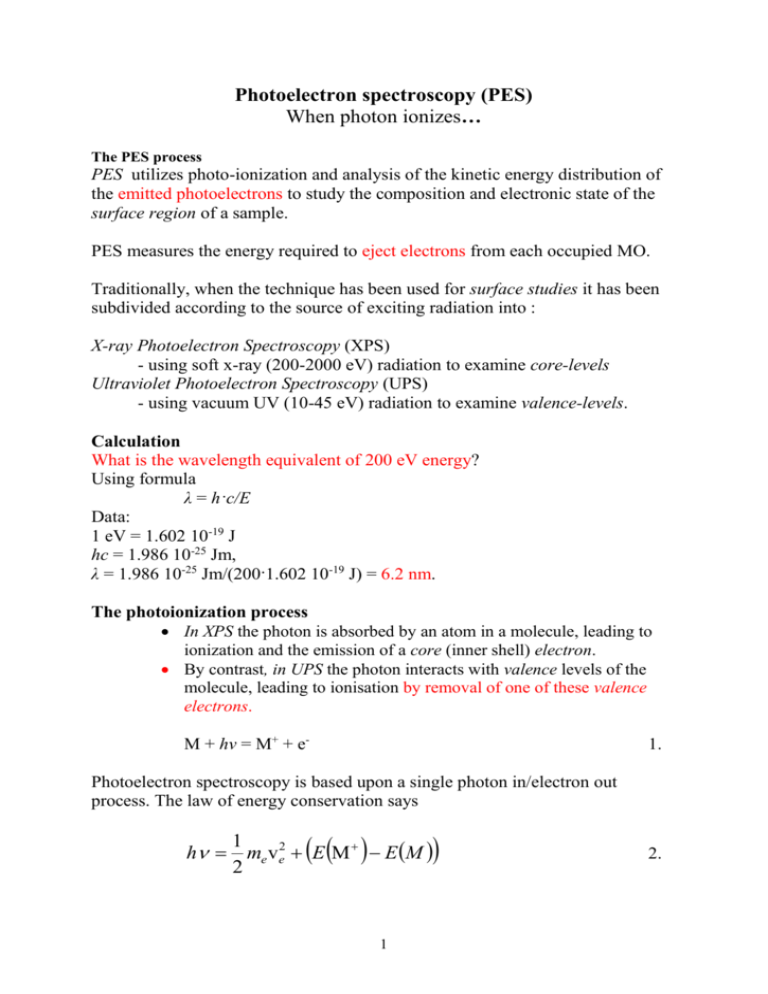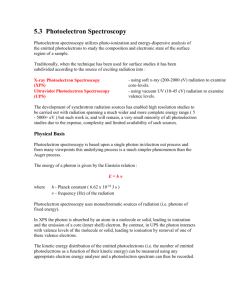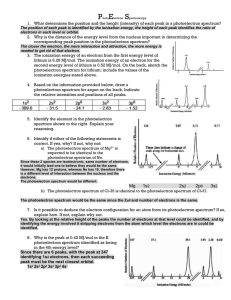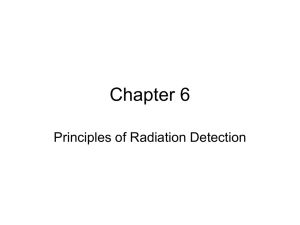Photoelectron spectroscopy - Laboratory for Chemical Kinetics
advertisement

Photoelectron spectroscopy (PES) When photon ionizes… The PES process PES utilizes photo-ionization and analysis of the kinetic energy distribution of the emitted photoelectrons to study the composition and electronic state of the surface region of a sample. PES measures the energy required to eject electrons from each occupied MO. Traditionally, when the technique has been used for surface studies it has been subdivided according to the source of exciting radiation into : X-ray Photoelectron Spectroscopy (XPS) - using soft x-ray (200-2000 eV) radiation to examine core-levels Ultraviolet Photoelectron Spectroscopy (UPS) - using vacuum UV (10-45 eV) radiation to examine valence-levels. Calculation What is the wavelength equivalent of 200 eV energy? Using formula λ = h·c/E Data: 1 eV = 1.602 10-19 J hc = 1.986 10-25 Jm, λ = 1.986 10-25 Jm/(200·1.602 10-19 J) = 6.2 nm. The photoionization process In XPS the photon is absorbed by an atom in a molecule, leading to ionization and the emission of a core (inner shell) electron. By contrast, in UPS the photon interacts with valence levels of the molecule, leading to ionisation by removal of one of these valence electrons. M + hν = M+ + e- 1. Photoelectron spectroscopy is based upon a single photon in/electron out process. The law of energy conservation says 1 h me ve2 E M E M 2 1 2. The total energy of photon is the sum of the binding energy, BE BE E M E M and the kinetic energy of electron. BE is the difference in energy between the ionized and neutral atoms, it can be identified the ionization energy (Koopman’s theorem). The method The kinetic energy distribution of the emitted photoelectrons (i.e. the number of emitted photoelectrons as a function of their kinetic energy) can be measured using any appropriate electron energy analyser and a photoelectron spectrum can thus be recorded. PES uses monochromatic sources of radiation. Figure 1. Schematic diagram of a photoelectron energy analyzer, detects the number of emitted electrons per unit time. Sample is placed in a high vacuum chamber (P ~ 10−8 millibar) for excluding other ionization processes than the studied one. The preferred option for photoemission experiments is a concentric hemispherical analyser (CHA) which uses an electric field between two hemispherical surfaces to disperse the electrons according to their kinetic energy. The higher the velocity measured the lower the ionization energy of photoelectron. 2 Examples Fig.2. The ionization process of H atom: H + hν → H+ + eA single band observed: ionization energy of 1s1 electron is13.6 eV = 1312 kJ/mol Fig.3. The ionization process of H2 molecule: H2 + hν → H2+ + eOne band spreading out from 15.45 eV to 18 eV, corresponding to ionization of the (σ)2 electrons. Sharp peaks (“fine structure”) due to vibration in H 2 . X-ray Photoelectron Spectroscopy (XPS) The intensity of the peaks is related to the concentration of the element within the sampled region. The most commonly employed x-ray sources are those giving rise to: Mg Kα radiation: hν = 1253.6 eV Al Kα radiation: hν = 1486.6 eV Each element will give rise to a characteristic set of peaks in the photoelectron spectrum at kinetic energies determined by the photon energy and the respective ionization energies. Core ionization energies are characteristic of the individual atom rather than the overall molecule. The presence of peaks at particular energies therefore indicates the presence of a specific element in the sample under study. 3 The XPS spectrum of Pd metal The diagram below shows a real XPS spectrum obtained from a Pd metal sample using Mg Kα radiation Figure 4. Kinetic energy (KE) peaks It is a trivial matter to transform the spectrum so that it is plotted against binding energy (BE) as opposed to KE. Figure 5. Binding energy peaks. The most intense peak at ca. 335 eV is due to emission from the 3d levels of the Pd atoms, whilst the 3p and 3s levels give rise to the peaks at ca. 534/561 eV and 673 eV respectively. 4 The XPS can distinguish between chemically inequivalent but otherwise identical atoms. Example: Sodium azide Fig. 6.The XPS spectrum of solid NaN3 excited by Al Kα radiation showing the region of N core ionization and the assignment. In the region of 400 eV the azide ion ( N 3 ) gives a doublet structure with splitting 6 eV in XPS spectrum. This range is typical of N1s electrons. The structure of the ion is characterized as, - form a: - NNN or form b: NNN and the XSP spectrum supports form a charge distribution. The peak position and integrated area under the peak are the factors we use for explanation in Figure. 6. The negative charge on an atom lowers the ionization energy while positive charge on the central atom raises it, because the repelling force lowers the ionization energy. Therefore, the higher intensity lower ionization energy peak belongs to the two negative N atom. The integrated intensity ratio is 2:1 for N- / N+. 5 Ultraviolet Photoelectron Spectroscopy (UPS) Koopman’s theorem ignores the fact that the electrons remaining rearrange their distribution when ionization occurs. Figure 7. The UPS spectrum of HBr. The lowest ionization energy band corresponds to the ionization of bromine lone-pair electron. The higher ionization energy band corresponds to the ionization of a bonding σ-electron. When ejected electron arises from bonding orbital, as in the case of HBr+ a vibration term, E v should be added to energy balance equation (Eq.2.). 1 h me ve2 I Ev 2 3. 6











